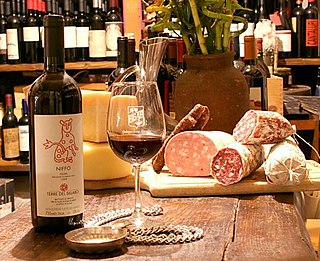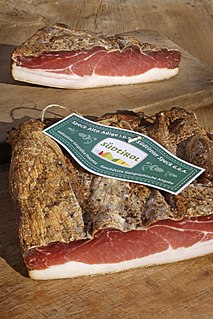 W
WCharcuterie is a French term for a branch of cooking devoted to prepared meat products, such as bacon, ham, sausage, terrines, galantines, ballotines, pâtés, and confit, primarily from pork.
 W
WSalumi is an Italian term describing the preparation of cured meat products made predominantly from pork. Salumi include bresaola, which is made from beef, and also cooked products such as mortadella and prosciutto cotto.
 W
WBresaola is air-dried, salted beef that has been aged two or three months until it becomes hard and turns a dark red, almost purple color. It is made from top (inside) round, and it is lean and tender, with a sweet, musty smell. It originated in Valtellina, a valley in the Alps of northern Italy's Lombardy region.
 W
WCapocollo, coppa, gabagool, or capicola is a traditional Italian and Corsican pork cold cut (salume) made from the dry-cured muscle running from the neck to the fourth or fifth rib of the pork shoulder or neck. It is a whole-muscle salume, dry cured, and typically sliced very thinly. It is similar to the more widely known cured ham or prosciutto, because they are both pork-derived cold-cuts used in similar dishes. It is not brined as ham typically is.
 W
WCiauscolo is a variety of Italian salame, typical of the Marche region, although it is also widely used in nearby Umbria.
 W
WCiccioli are pressed cakes of fatty pork. They are known under this name in Emilia Romagna, being popular in Modena, Reggio Emilia, Bologna, Parma and Romagna. In Naples they are called cicoli. In Lazio and Umbria they are called sfrizzoli. In Calabria they are called risimugli.
 W
WCotechino Modena or Cotechino di Modena [koteˈkiːno di ˈmɔːdena] is a fresh sausage made from pork, fatback, and pork rind, and comes from Modena, Italy, where it has PGI status. Zampone Modena is closely related and also has PGI status.
 W
WProsciutto is an Italian dry-cured ham that is usually thinly sliced and served uncooked; this style is called prosciutto crudo in Italian and is distinguished from cooked ham, prosciutto cotto.
 W
WFinocchiona is a salami variety, typical of Tuscany, Florence area. It is characterized for the use of fennel.
 W
WGuanciale is an Italian cured meat product prepared from pork jowl or cheeks. Its name is derived from guancia, the Italian word for 'cheek'.
 W
WLardo is a type of salumi made by curing strips of fatback with rosemary and other herbs and spices.
 W
WThis is a list of notable sausages. Sausage is a food usually made from ground meat with a skin around it. Typically, a sausage is formed in a casing traditionally made from intestine, but sometimes synthetic. Some sausages are cooked during processing and the casing may be removed after. Sausage making is a traditional food preservation technique. Sausages may be preserved.
 W
W'Nduja is a particularly spicy, spreadable pork from Italy. It is very similar to sobrassada from the Balearic Islands in Spain. It is typically made with parts of the pig such as the shoulder and belly, as well as tripe, roasted peppers and a mixture of spices. It is a Calabrese variation of salumi, loosely based on the French andouille introduced in the 13th century by the Angevins.
 W
WOlympia Provisions is an American meat and restaurant company that produces artisan charcuterie based out of Portland, Oregon. It has five restaurants.
 W
WPancetta is a salumi made of pork belly meat that is salt cured. Pancetta in Italy is typically cooked to add depth to soups and pastas.
 W
WPitina, Peta or Petuccia is an Italian cold cut (salume) originating in the Dolomite valleys of Tramonti di Sopra and Tramonti di Sotto, and the River Cellina, in the northeastern Italian province of Pordenone in Friuli. It is not a true sausage, but a meatball made of smoked meats. The recipe was probably based on the impromptu need to preserve game. The preparation method did not require specialized equipment making it available to all homes, even the most isolated mountain huts.
 W
WProsciutto is an Italian dry-cured ham that is usually thinly sliced and served uncooked; this style is called prosciutto crudo in Italian and is distinguished from cooked ham, prosciutto cotto.
 W
WSalami is a cured sausage consisting of fermented and air-dried meat, typically pork. Historically, salami was popular among Southern, Eastern, and Central European peasants because it can be stored at room temperature for up to 40 days once cut, supplementing a potentially meager or inconsistent supply of fresh meat. Countries and regions across Europe make their own traditional varieties of salami.
 W
WA salumeria is a food producer and retail store that produces salumi and other food products. Some only sell foods, while not producing on-site, and some have a restaurant with sit-down service. The salumeria originated in Italy, and dates to the Middle Ages.
 W
WSoppressata is an Italian dry salami. Although there are many variations, two principal types are made: a cured dry sausage typical of Basilicata, Apulia, and Calabria, and a very different uncured salame, made in Tuscany and Liguria. It is still part of southern Italian cultural heritage that local people slaughter the pig themselves and use it all, with nothing going to waste, using some parts to make cured meats including soppressata. Soppressata is sometimes prepared using ham.
 W
WSopressa [soˈprɛssa] is an Italian aged salami, produced with pork, lard, salt, pepper, spices and garlic. It is a typical product of Veneto, in northern Italy.
 W
WSpeck is smoked or pickled pork belly. In Germany, speck is pork fat with or without some meat in it.
 W
WSpeck Alto Adige PGI is a dry-cured, lightly smoked ham, produced in South Tyrol, northern Italy. Parts of its production are regulated by the European Union under the protected geographical indication (PGI) status.
 W
WStrolghino [strolˈɡiːno] is a salami in Italian cuisine that is prepared from pork. It is thin, with an average weight of 300 grams, and may be prepared from the "lean leg meat" of the domestic pig. Leftover cuts of meat from the preparation of culatello prosciutto are typically used. It may be prepared from parts of the pig that are not used in ham. Strolghino may only be available for only a few months in some areas. It may have a relatively short curing time of 15–20 days, which results in a very tender product resembling "fresh, raw sausage meat".
 W
WTyrolean Speck is a distinctively juniper-flavored ham originally from Tyrol, a historical region that since 1918 partially lies in Italy. Its origins at the intersection of two culinary worlds is reflected in its synthesis of salt-curing and smoking.
 W
WVallée d’Aoste Lard d’Arnad (PDO) is a variety of lardo produced exclusively within the municipal boundaries of the commune of Arnad in lower Aosta Valley, Italy. It was awarded European Union protected designation of origin (PDO) status in 1996 and is promoted by the Comité pour la valorisation des produits typiques d'Arnad - Lo Doil producers association.
 W
WVentricina is a pork sausage commonly found in the Abruzzo region of central Italy. It is similar to certain luncheon meats, included in the category English-speakers from the United States refer to as "cold cuts". It is traditionally made using relatively low grade, very fatty pig meat cuts and encasing them in the animal's intestines or stomach while they cure. There are two principal types of ventricina: those of the area in and around the city of Teramo, and others coming from the area of Vasto.